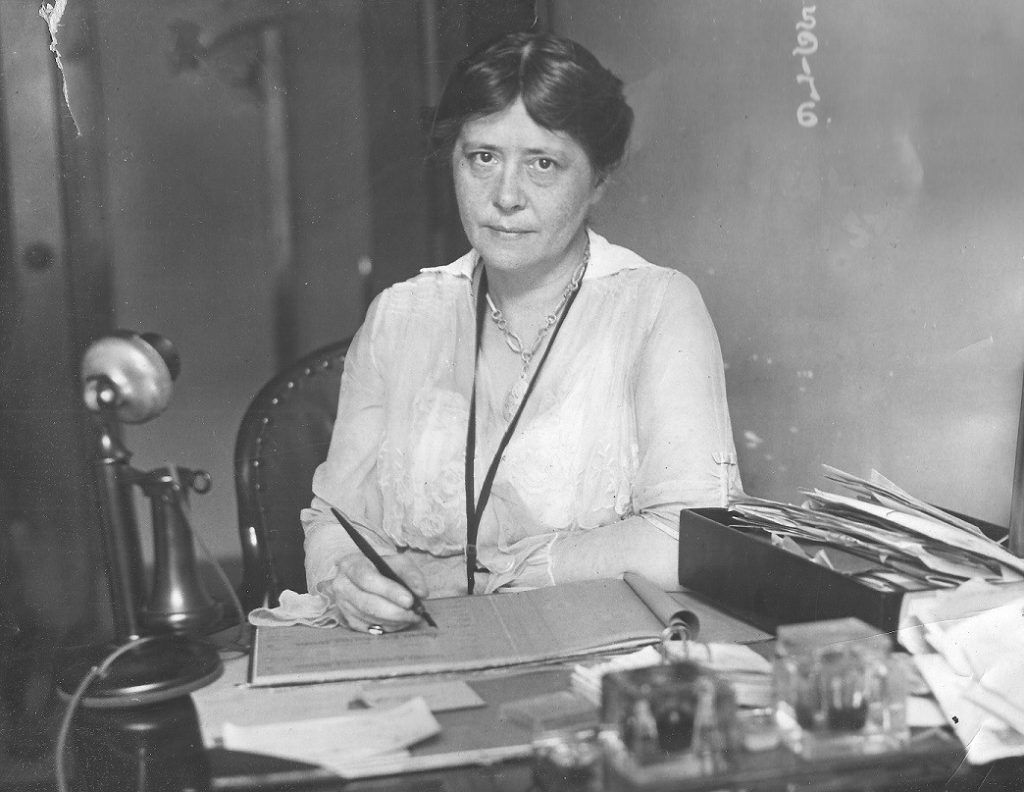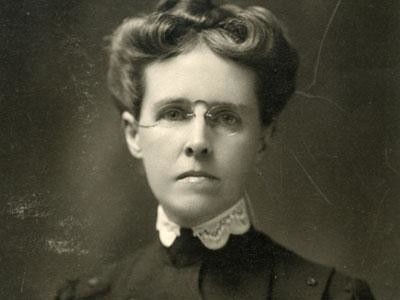The history of crime-fighting in Britain and America was, for a long period, an overwhelmingly male-oriented narrative. Though fictional female detectives, police officers, and amateur investigators populated commercial literature throughout the nineteenth-century, options for real women to pursue detection were not available until close to the twentieth.
The London Metropolitan Police, founded in 1829, first hired female employees in 1888 (to assist female prisoners), but women were not permitted to work as investigators until 1914. In America, individual states began to appoint women to police capacities at different times, but the first appointment seems to have been in 1891 in Chicago (although, as covered recently in CrimeReads, the Pinkerton National Detective Agency, a private company, hired Kate Warne in an investigative capacity as early as 1856). Slowly, other cities slowly began to follow suit.
These first women to join the police as detectives illuminate an early step towards overcoming widespread female oppression. But trailblazing isn’t a one-track act. The early lady detectives navigated the male-dominated sphere in many different ways, to different ends. Some were caught up in office politics, infighting, and the pitfalls of police exceptionalism. Others became galvanized to use their successes to aid other women. And then there were the women who were just trying to make a living. But they remind us that it takes many steps, in all directions, for a culture to truly move forward on an issue.

Marie Connolly Owens
Marie Connolly Owens was the first woman hired as a full police officer in the United States. In 1888, Owens, a Chicago mother of five children, was widowed. She had never held a job, but was determined to provide for her family. She was hired by the city as a sanitary inspector—a new position created in light of legislation preventing children from working under age 14. Owens was one of five women hired to review workplaces and ensure safe conditions, as well as identify children working illegally. Owens went above and beyond, working to find alternate forms of income for them, by herself.
But Owens had another mission, as well—tracking down husbands and fathers who had abandoned their families, causing their children to begin working to help supplement income. When Owens found these absentee men, she would turn them over to the police. She brought in so many, that Chicago’s Police Chief Robert Wilson McClaughrey grew impressed and hired her. She was appointed as a Sergeant—with full privileges. She spent her career enforcing child labor and education laws.
Owens is a complicated torchbearer—while she was a police officer with no differing responsibilities and authorizations than her male counterparts, she also was determined to show how her work was different than “masculine” police work.“I never go out looking for robbers or highwaymen. That is left for the men. … My work is just a woman’s work,” she said in an interview.
Indeed, as Livius Drusus has observed, “In almost every contemporary news article about her, her success in law enforcement was subsumed under her femininity, maternal instinct, charitable nature, and kind heart.” While this reveals the mass anxiety about women behaving in capacities reserved for men, and is an attitude which contributed to the social repression of women even while it facilitated their professional progress, Owens’s work also productively expanded the idea of what the police could do. Owens single-handedly made the Chicago police department pay attention to and act on behalf of single and working mothers and families.

Mary Grace Quackenbos Humiston
Mary Grace Quackenbos Humiston, a graduate of Hunter College and New York University Law school (coursework for which she finished a year early, graduating seventh in her class), was the proprietor of her own law office, the People’s Law Firm. Independently wealthy, her goal was to provide working people with “St. Regis Law at Mills Hotel prices,” focusing on cases on behalf of very poor and immigrant clients. In 1905, she solved a case that had baffled the police until they dropped it—the robbery of $3,000 worth of jewels from the Spanish Legation Secretary.
In 1907, she became well-known for presenting evidence on behalf of an incarcerated immigrant woman that commuted her death sentence. Around this time, working several missing persons cases, she uncovered a giant peonage scheme—the luring of poor workers and immigrants to the South to work in slave-labor conditions on turpentine and other plantations. She went undercover and infiltrated many of these camps, gathering enough evidence for the Justice Department to open an investigation. She was then appointed Special Assistant United States District Attorney for the Southern District of New York and, finally regarded as a specialist on peonage, was sent by the Secretary of State to investigate further trafficking. In 1916, she famously represented a death row inmate at Sing Sing, producing evidence of a false conviction that set him free.
…she became known to the public as “Mrs. Sherlock Holmes” in 1917, when she solved a famous cold caseBut she became known to the public as “Mrs. Sherlock Holmes” in 1917, when she solved a famous cold case—the disappearance of an eighteen-year-old-girl named Ruth Cruger, who, months before, had left her house in Harlem to get her ice skates sharpened and never returned. The police insisted that Ruth had likely run away, and left the case alone. Working pro-bono for the desperate family, Humiston concentrated on the skate-sharpening shop where Cruger was last seen, interviewing countless neighbors. She was certain that the owner, Alfredo Cocchi (whom the police had refused to investigate because of his respectable repute) was behind Ruth’s disappearance—which seemed to be an even more viable theory after he suddenly left the country.
One of Humiston’s sources told her that, around the time of Ruth’s disappearance, Cocci had emerged from his cellar, covered in dirt. Humiston scoped out Cocchi’s house—securing a search warrant, and directing her team to dig up the floor of the basement. There, they found Ruth’s body. But Humiston also uncovered a connection between Cocchi and the police—a kickback system between local officers and the repairman that likely protected him from suspicion and allowed him to abscond. After this, Humiston was appointed Special Investigator with the New York City Police Department, to continue to track down missing women and girls.
 Lilian Wyles
Lilian Wyles
Lilian Wyles was the first woman to be hired as a full police officer in Great Britain. A nurse who served in World War I, Wyles began working for the National Council of Women Workers in 1918. Because her job was to patrol the streets, she was hired in 1919 by the London Metropolitan Police as one of twenty-five women patrolers. By 1921 she had been promoted to Inspector. As in the United States, London’s Metropolitan Police wanted a woman in their ranks to deal with sensitive cases related to women and children. In 1923, she was given power of arrest. She principally worked with victims of sexual assault, and on a shoestring budget, sought to help victims rehabilitate—she would provide women with clean clothes, and take their statements in her own apartment.
But Wyles was also caught up in a masculine world that was staunchly unwelcome to her presence—and this proved difficult to navigate. In 1928, she was presented with a difficult situation that, if she acted as a female ally, might have sunk her career. In 1928, an MP and his girlfriend, Irene Savidge, were arrested for public indecency. Savidge was brought to Scotland Yard for questioning, with Wyles as her chaperone. But before the interrogation, Chief Inspector Alfred Collins dismissed Wyles, insisting on questioning Savidge alone. Afterwards, Savidge accused Collins of sexually harassing her during the interview—claiming that he asked her inappropriate questions, and touched her hand and knee. In the formal inquiry, when she was called to give evidence, Wyles lied on behalf of her boss—saving him from (due) punishment, and preserving the department’s reputation. After this moment, apparently, the male officers in the department began to see her as one of their own. Wyles’s story reminds us of an unfortunate historical truth—that the promotion of a woman to a position normally held by a man does not automatically contribute to a system which respects or supports women.

Maud West
Based on London’s Baker Street, Maude West was a well-known private detective who established her own agency in 1905. She employed both women and men as detectives, and took cases, herself. Famous for being a master of disguise (she had “looks” for many occupations and class positions, for both male and female characters), she was famous for being able to completely disappear into new identities. She wore disguises to tail suspects, but also went deep undercover for other cases, sometimes taking jobs as housemaids or secretaries to gather more detailed evidence. Once, she explained, she took rooms at a hotel as a man, and stayed for two weeks to shadow someone (though, lest she appear too transgressive, she insisted that she did not wear men’s clothing when she was alone in the suite).
Much of her work involved locating spouses or searching for missing persons, but some of her more outlandish cases were profiled in the press—including a rip-roaring adventure throughout Europe and America, detailed in The Pittsburgh Press in 1913, wherein she was hired by a wealthy American woman to tail her husband. His mysterious outings, West (who followed him while dressed in numerous male disguises) discovered, were actually trips to meet with a disreputable doctor, who was illegally procuring corpses for the husband’s human dissection hobby.
West, who received lots of fan mail from women and men alike, was vocal in explaining how women naturally possessed skills that would allow them to accomplish superb detective work–as long as they would be willing to disguise themselves, and specifically dress as men. She was adamant that men had the sole privilege of being able to stand around without attracting attention. But still, she advised against women joining the profession—if only because it was so fatiguing and time-consuming. Not just any woman, she (disappointingly) maintained, could keep up with the lifestyle.

Lola Baldwin
Lola Baldwin, a forty-eight-year-old mother of two, was appointed to the police department in Portland, Oregon as the city’s first female police officer in 1908. She had previously worked for Traveler’s Aid Society, helping to design the Lewis and Clark Centennial Exhibition to ensure the safety of young woman visitors (she managed a team of patrollers who spread throughout the park, to provide assistance to women caught in or lured to isolated areas).
Promoted to the rank of detective, she quickly became the Superintendent of the Women’s Protective Division, which sought to keep young women from becoming embroiled in wayward or corrupt lifestyles. Baldwin was influenced heavily by the Social Hygiene Movement (an anti-prostitution and vice outfit), and crusaded against the spread of venereal diseases and other physical dangers of the sex industry, and worked to close down establishments she believed were exploiting young women (though this did extend, unfortunately, to dance halls).
Though somewhat puritanical in her definitions of female endangerment (and critical of demonstrations of female freedom), Baldwin was not a believer in punishing women for what she believed were their turns towards dangerous lifestyles; she organized many social services and other programs to help working women and single mothers, and especially the women she removed from promiscuous industries. Her primary concern was their physical safety. And she spent her career advocating for equal benefits for female police officers.
***
Not mentioned in this list, but also significant to the entrance of women to this industry were Pinkerton detective Kate Warne, Los Angeles police officers Alice Stebbins Wells and Minnie Barton, Long Beach police officer Fanny Bixby, New York City detective Isabella Goodwin, and New York City medical detective Frances Benzecry, among other pioneers.

















